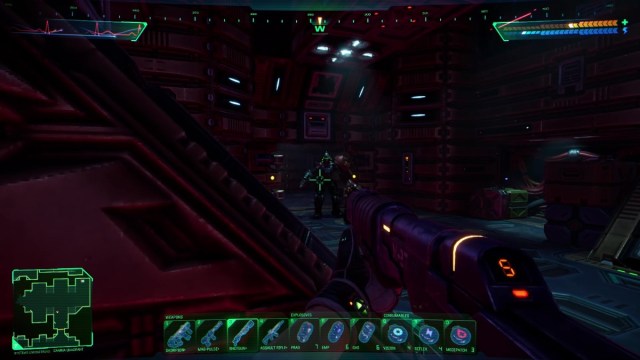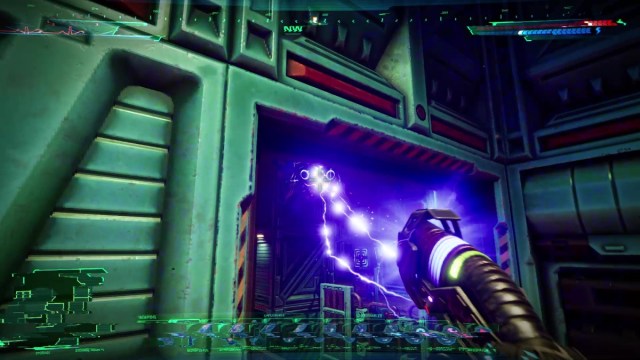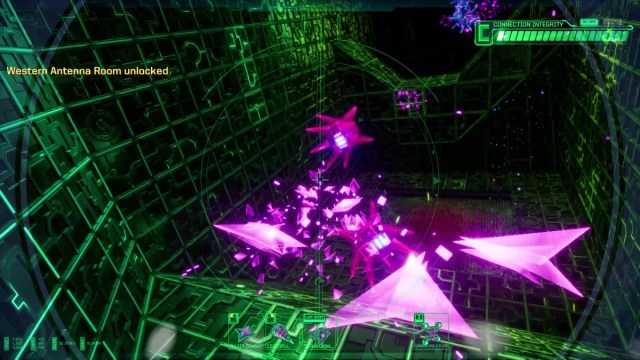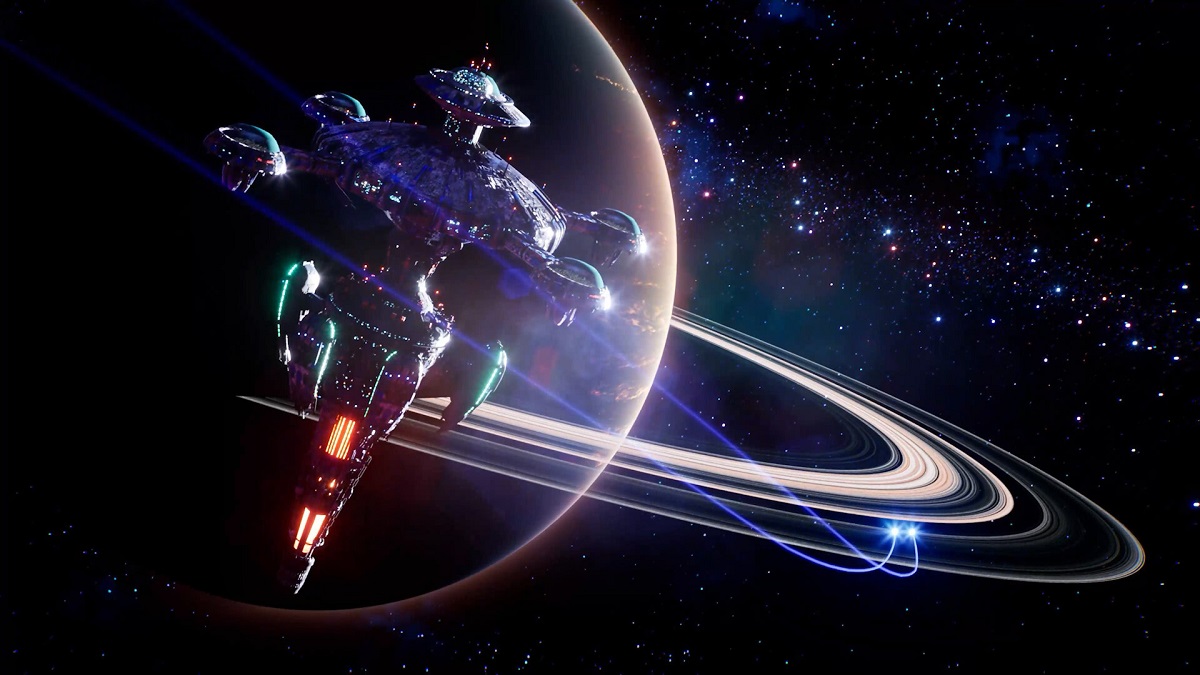System Shock 2023 isn’t a remake. It’s a historical reenactment.
Nightdive Studios has taken the story and setting from the original 1994 game and replaced many of the mechanics, turning a dungeon crawler into an immersive first-person shooter. It’s still recognizably 1994’s System Shock, but now plays more like 1999’s System Shock 2.
If you’re coming in cold, System Shock 2023 (SS23) is a deliberately retro sci-fi/horror FPS that puts you up against one of video games’ classic villains, the hostile artificial intelligence SHODAN. It’s tense, engaging, and often deliberately unfair. More importantly, it has almost none of the mechanical quality-of-life bonuses that you might’ve come to expect from games made in the last 20 years.
SS23 wants you to get lost. It requires you to take notes. If you’re stuck in a maze of identical corridors with no ammo, little health, enemies around every corner, and no idea what you’re supposed to do next, that’s absolutely the intended SS23 experience.

System Shock 2023 is set in the ‘90s vision of the future, in the cyberpunk 2070s. You’re a nameless hacker who gets captured by agents of the TriOptimum corporation. Those agents bring you to Citadel Station, a mining facility in orbit over Saturn, where its commander Edward Diego blackmails you into disabling the ethical constraints on the station’s AI SHODAN (Sentient Hyper-Optimized Data Access Network).
To sweeten the deal, Diego throws in a military-grade hacking implant, but the installation requires you to spend a few months in a recuperative coma. When you wake up, the newly-unshackled SHODAN has taken over Citadel Station, killed most of its crew, and is preparing to weaponize its systems to destroy Earth. Now it’s up to you to fix what you broke.
SS23 is a survival game, occasionally verging on survival horror. Weapons and ammunition are reasonably easy to come by, but health isn’t. This is the sort of game where every individual encounter typically costs you something, so the trick is to use up only the resources that you can afford to spend.

On each of Citadel’s decks, SHODAN initially has full control of its systems. She’s populated each level with hacked robots and hostile mutants, and can send in replacements at any time until you destroy her local network. I’ve gotten killed more than once because SHODAN spawned a fresh murder robot in my blind spot at the worst possible moment.
You spend most of SS23 in cramped maintenance tunnels and industrial zones, all colored in strange reds, purples, and blues. Every floor of Citadel Station is a sprawling, elaborate maze full of secret doors, crawlspaces, and unnecessary switchbacks, just as they were in the original.
It all creates the subtle impression that Citadel was grown, rather than made. This isn’t a space station at all; you’re crawling through the guts of some massive, mechanical monster.
That surreal feeling extends to the game’s overall mission objectives. It’s not that they’re obscure, but rather that SS23 isn’t interested in belaboring any of its points. You’ll often be told what to do once, in an audio log or radio message, with few if any details about how to do it.
Sometimes that means flipping an unlabeled switch in an unlabeled room on the far side of a map; other times, it involves collecting a 6-digit passcode one digit at a time — from six separate levels of Citadel Station.

It’s not as obtuse as that makes it sound, but it makes me appreciate how much effort modern games put into their mission objectives. In SS23, I often forgot what I was supposed to be doing, because it took all my attention and effort just to survive. I’d end up surrounded by locked doors and wrecked robots with no clue what to do next, because I’d missed a lever or ladder somewhere along the way.
That elaborate push-pull gives SS23 an impressive, slow-building tension, particularly in conjunction with its subtly menacing soundtrack. Your resources are sharply limited, but your enemies aren’t. Every extra minute you have to spend on figuring out what to do next is another minute that SHODAN can use to repopulate the rest of the level around you. You always feel like you’re racing the clock.
It’s an old-school sort of difficulty, although it’s not long before its cracks start to show. Individual enemies in SS23 are dumb as posts. Individually, they’ve all got basic patterns that are easy to exploit. They’re only dangerous because they do a lot of damage; because they’re a resource sink; or most frequently, because a half-dozen of them suddenly showed up out of nowhere.
The latter’s particularly obnoxious in the late game when you reach the security deck, which is patrolled by silent UAVs with missile pods. I’d be minding my own business when I’d suddenly get liquefied by a drone strike. That’s not entertaining or immersive — it’s just dumb.
The AI’s stupidity is one of those issues that you probably won’t notice on an initial run, but it’s obvious on a replay or on multiple attempts at a single encounter. I’ve seen enemies take themselves out with their own proximity mines, blow each other up with grenade launchers, or forget they’re supposed to be fighting me.
This also isn’t a game you pull out to amaze friends with the power of your gaming hardware. SS23 looks like an HD remaster of a PlayStation 2 game, especially whenever you’re fighting mutants. The robots all look appropriately murderous, especially the security droids, but both mutants and human corpses look like a cheap practical effect from an ‘80s B-movie.
System Shock Review — The Bottom Line

Pros
- Lo-fi but immersive.
- Difficult, but largely fair once you figure it out.
- SHODAN remains one of the great video game villains.
- A genuinely unnerving experience, without jump scares or brassy musical stings.
Cons
- It’s sort of ugly, even if it is on purpose.
- The enemies are all really dumb.
- Deliberately made to play like a 25-year-old game.
- The cyberspace hacking minigame gives me a headache.
There’s a lot about System Shock that still feels like it’s almost 30 years old, and most of the updates that Nightdive has made are in the service of making it feel like it’s “only” almost 25. It’s outdated mechanically, narratively, and visually, all of which was clearly in the service of making SS23 feel like a lost retro classic.
It’s still one of the most tense experiences in any game this year, and most of its decisions only work in its favor. Citadel Station doesn’t make sense, and that’s part of what makes it dangerous. If you can deal with that, and if you enjoy this sort of nail-biting, razor’s-edge gameplay, System Shock 2023 is well worth your time.
[Note: Nightdive Studios provided the PC copy of System Shock used for this review.]










Published: May 30, 2023 01:29 pm